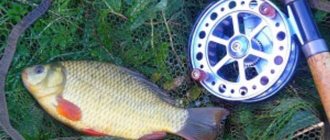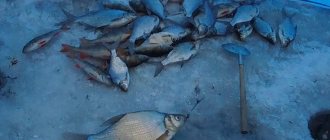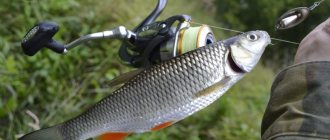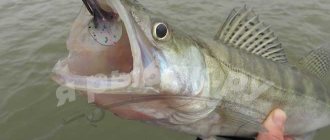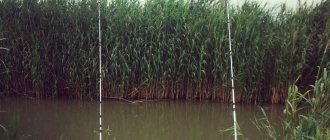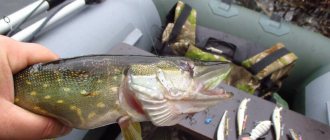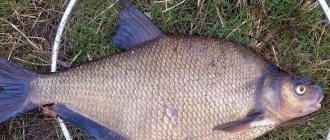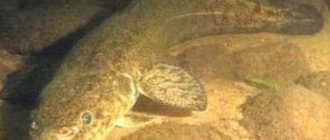Bream fishing in October
Bream fishing in October.
Some anglers are mistaken in believing that with the onset of mature autumn, fishing for white fish ends. We cannot agree with this opinion, because many of their colleagues prove the opposite in practice. Of course, in October it is already quite cold and the whites react to the drop in temperature. Bream, for example, gather in schools, occupy deep holes and stop actively feeding, but this does not mean that they cannot be effectively caught. In mid-autumn, they no longer come to the shore, and do not move at all, so the main task in autumn bream fishing is to find its resting place. After this, all that remains is to choose bait with which he can be tempted.
In autumn you can’t count on an active bite; it’s good if there are several confident bites per day. But during this period there are more chances to get a trophy. If you are carried away by the fishing process, you can forget about the autumn-winter restrictions and run into an unpleasant conversation with fisheries inspectors. In many regions, fishing in wintering pits is prohibited in the second half of autumn. You need to monitor this and know exactly from what date the ban was introduced and which bodies of water it applies to. This is the only way to avoid trouble.
Search
If during September fishing the fish can be pulled to the selected point with bait, then fishing for bream in November is considered exploratory. The fishing tactic is to first actively look for fish, then, having found it, feed and catch.
In order to catch bream in November, some anglers use two fishing rods. One feeder is used to search for fish, and the second is used to fish in the found place. This method often gives results also because a shy school in clear water can leave after the fisherman manages to catch a couple or three bream.
When searching for bream in October - November, you need to pay attention to the deep places of the river that border on shallows: edges, exits from holes, steps. It is here that schools of bream often linger, feeling relatively safe from predators.
Finding bream in October
In September, if it turns out to be warm, the bream continues to look for food and feed, but the closer winter comes, the lower its activity. In October, the fish begins to prepare for the winter, looks for suitable depressions on the bottom, and stays in limited areas, so the key to success will be a deliberate choice of fishing location. Bream reacts painfully to external factors; sudden weather changes affect its location. If weather forecasters promise a drop in temperature, strong winds or precipitation, it is better to stay home. On such days, the fished object hides in its shelter and does not respond to bait.
In the middle of the autumn season, a school of bream can be found at relatively shallow depths in places where the already weak rays of the sun are still warming the water. When the thermometer drops, the fish move to deeper parts of the riverbed zone, closer to the wintering pits. In order not to look for a needle in a haystack and not waste time, it is recommended to start searching where there is a suitable depth, a weak current and a thick layer of silt. Small breams (breams) can stand above the sandy ground, but a real bream is not interested in them.
Whether or not to feed bream in October is a personal matter for each angler. The effectiveness of bait again depends on the correct choice of fishing location. If there are no fish at the selected point, no secret mixtures will make it appear there. That is why you should not linger in those places where there has not been a single bite for two or three hours.
How to catch October bream?
Since in autumn this fish lives mainly in the bottom horizons, bottom gear will be more effective in catching it. You can fish from the shore or from a boat. Let's look at several methods that experienced breamers call the most effective.
Autumn bream fishing
With the end of the summer heat, due to the gradual decrease in temperature in reservoirs, this representative of cyprinids no longer approaches the shore during the daytime.
In mid-autumn, in October, you can catch a trophy specimen, which is very rare even in summer. Therefore, catching bream in October using a feeder, a donk and a ring is quite common. This fish leads a sedentary life and is considered very cautious. She can stay in one place for a very long time, although if she is frightened, she will swim away from her habitat even during spawning and will never return there again.
Catching bream in October on a feeder
Feeder fishing for bream in autumn is almost no different from summer, but it is still worth considering some nuances. Firstly, as mentioned above, you should choose the location wisely and look for a deep area. Then the selected point is fed and you can begin fishing directly. It should be noted that by mid-autumn, the fish being caught has already accumulated a sufficient amount of fat for the winter, eats less and behaves much more cautiously than in the summer months. Feeding trips last no more than 2-3 hours, usually from 8 to 11 am and after 14.00-15.00. Autumn bream bites can be described as very indecisive, but the angler can change the situation if he uses the most delicate equipment (a thin leash, a fairly heavy but oversized feeder, a minimum of accessories). An asymmetrical loop works great, and in October such classic installations as paternoster and symmetrical loop perform well.
Due to the decrease in temperature, the bream moves further and further from the coastline, so you can only get it with a long cast. To fish on a large river for exits from channel holes located at a decent distance from the coastline, you will have to use a long rod (at least 3.5 meters) and heavy long-range feeders weighing from 80 g. The main fishing line can be 0.30 mm monofilament or braided cord 0.16-0.20 mm, leash – as thin as possible. Experienced feeder athletes manage to pull out a bream weighing 1 kg with a leash with a diameter of 0.12 mm, but if you don’t have the necessary skills, it’s not worth the risk. It is advisable to discard anti-twist tubes; their function can be performed by simple twisting.
Catching bream in October on a donk
Due to the growing popularity of the feeder, there are fewer and fewer fans of fishing with a regular donk with a sinker. And it’s completely in vain, because with the help of this gear you can catch several decent specimens and get great pleasure from fishing. Donka is especially relevant in the fall, when the days become short. When fishing with a feeder, a lot of time is spent on preparing the tackle, preparing the bait mixture, and feeding the point, but with a donkey everything is much simpler. Collect it, put the bait on the hook, throw it in and catch it.
Recommendations regarding the elements of gear are as follows.
- You can take a feeder or spinning rod with a length of at least 2.4 meters, powerful enough to support large bream. The test range must correspond to the weight of the sinkers used.
- The reel is a spinning reel with a spool that can hold 100 or more meters of fishing line with a cross section of 0.35 mm. You should not use a reel that is too bulky or heavy, as this will upset the balance of the gear. Basic requirements for it: good line laying, easy movement, trouble-free operation.
- The main line is monofilament 0.3-0.35 mm. You can use a thicker one, but in this case you will have to use a larger reel and a heavy load, which will make the tackle coarser.
- Sinker - a lead bullet for still water or a spoon for fishing in currents. For autumn, a sliding one is better, since with the slightest resistance the bream can spit out the bait.
- Leashes. Usually there are two of them of different lengths, so as not to get confused. The optimal diameter is 0.18-0.20 mm.
- Hooks are high quality, sharp, made of thin wire.
If you have a boat, you can catch autumn bream from it with even simpler gear called a zakidushka. There is no rod and reel, so you have to cast by hand.
Fishing for bream in October with a ring
In the world of high technology, which has also affected the fishing industry, many old-fashioned tackles are forever a thing of the past. Some are still “keeping afloat” because they are able to compete adequately with the English donkey and other fishing gear that is fashionable today. An example is the ring - a half-forgotten tackle that perfectly catches white fish in the current. It consists of several simple elements:
- a short rod designed for side fishing;
- equipment, including a fishing line, a lead ring with a slot and leashes with hooks;
- a mesh feeder bag that can hold up to 3 kg of bait;
- thick fishing line or cord holding the feeder (the equipment is lowered to the bottom along it).
The principle of operation of the ring is simple. The bait sinks to the bottom directly under the boat, and the food that attracts fish is gradually washed out of the bag in the direction of the hooks with bait. After the bite, the hooked prey rises to the top along with the ring. You need to pull the line out by hand. In the same way, along the fastening line, the ring with the replaced bait returns down.
At first, some difficulties may arise in handling this catchy tackle, but after getting better at it and gaining experience, fishermen manage to fish with two or three fishing rods at once. It is important to understand that in standing water it is ineffective, since without a current the food will not be washed out of the feeder and create an attractive feed trail.
Catching bream in October with a float rod
There is nothing to do on the river in the middle of autumn with such gear, except perhaps just fish from a boat on a river-bed dump. From the shore you can catch small bream, but there is no talk of catching large bream. But in reservoirs, using a fishing rod you can successfully catch individuals weighing up to a kilogram in deep places located in the coastal zone. To increase the casting range, it is equipped with a reel.
A fishing rod for fishing bream in October is a standard set for long-distance casting. What does it include?
- A fishing rod with guides 5 to 7 meters long. Windy weather is common this month. It is not easy to control a long rod in the wind, so a 5-meter rod would be the best option. It is easier to hold it in gusts of wind and it will cast far enough.
- Light class spinning reel for match fishing. The spool size is 1500 or 2000. If there is no need for long casting and the reel is needed only for storing fishing line, then you can install an inertial model.
- High-quality fishing line 0.23-0.28 mm. When choosing, you should take into account that a thick fishing line has a greater windage, and this negatively affects the fishing process.
- It is advisable to install a float that is narrow-bodied and long, so that it can be easily seen from a great distance. When biting autumn bream, the goose feather type float usually falls to one side.
- The weight is a set of lead pellets distributed along the fishing line so that the float is in a vertical position, protruding about a third above the water, and the hook with bait lies at the bottom.
- A leash is used with a length of 20 to 50 cm, depending on the strength of the current. Recommended diameter is 0.18 mm.
- The hook is high quality, properly tempered. It should neither break nor bend, which often happens when fishing for large bream. The size is selected for a specific bait. For a worm, No.9 is suitable, but for fishing with bloodworms it is better to use a smaller one - No.6.
A float rod is not the best tackle for catching bream in the fall, but with some luck you can also have fun and productive fishing with it.
Autumn baits and groundbaits for bream
At the end of the season, the taste preferences of the fished object change. If in the summer he willingly took on corn, pearl barley and other plant baits, then in cold water he gives preference to various living creatures. At the beginning of October, bream can be tempted with maggots, later worms are used, and when it gets very cold, it is better to offer it bloodworms. Although this fish is not a predator, in the pre-winter period large specimens are caught on the bait of spinning rods, so you can try fishing with fry.
Of all the baits listed, the most effective for October is the dung worm. It has a specific smell, and its mobility makes it attractive. A fresh worm wriggles around the shank of the hook, thereby tempting the passive bream. A catch bait is also the underleaf worm, which can be easily found in the lower layers of fallen leaves. Sometimes sandwiches work well, for example, a worm “propped up” with maggots.
Autumn bream are fed with plant-based mixtures, not forgetting to add animal components to them. Here is one of the simple recipes for autumn:
- sunflower cake – 30%;
- breadcrumbs – 20%;
- clay or soil taken from the shore of a reservoir – 30%;
- maggots or crushed worms – 12%;
- small pieces of unsalted lard - 3%.
Bream fishing in October: secrets of successful fishing
Although some believe that with the advent of cold autumn days, active fishing for white fish ends, there is every reason to disagree with this opinion. A significant role here is played by changes in the behavior of fish compared to the summer period. Bream, reacting to the colder weather, begins to gather in large flocks in various holes for the purpose of a calm and cozy wintering. At this time, he practically does not approach the shore and becomes less and less active every day. But the fact that in the fall a fisherman has a much greater chance of catching a trophy specimen compared to the summer forces avid anglers to adapt to any conditions. In this regard, bream fishing in October promises to be very successful.
Lure
Now let's talk about the features of feeding fish during different periods of the autumn season. If we noted about September fishing that it is similar to summer fishing, then bream fishing in October is already significantly different in terms of bait. The animal component of the mixture comes to the fore, capable of not only attracting fish, but also keeping it at the feeding point by adding bait to the composition.
As the water gets colder, soil components are increasingly being introduced into bait mixtures. Moreover, with each fishing trip, the soil part of the bait becomes more and more significant, and by winter it can completely displace the fine-grained bulk components. Often the bait consists only of soil and bloodworms.
It is worth saying that in places with a quiet current or its complete absence, fine-fraction compositions are used, and on a river with a good current, porridge is more often used or large fractions are added.
Change of habitats
The closer to frost, the less active the fish are moving.
Bream going for the winter looks for secluded corners and stays in a limited area, so finding a place is perhaps the main criterion for successful fishing in the fall. It is believed that it is October that pleases with large trophies, but changeable weather greatly affects the bite and location of the fish.
In autumn, bream can also be found at medium depths, but only where the sun's rays are still able to warm the water. A decrease in temperature moves the fish closer to the bottom into wintering pits, where they gather in large numbers. Mostly such places are connected to the riverbed. Bream loves warm bodies of water with a weak current, with a muddy, but not shaded bottom. Small individuals can stand on sandy soil. It is unlikely that you will be able to lure this fish to feed in a place that will be uncomfortable for it, so you need to check the area at random. If there are no bream bites at the feeding point for several hours, move on to the next one.
October tackle for bream
Since autumn bream mainly lives near the ground, it is preferable to fish for it using different types of bottom equipment. Let's look at the two most successful methods of fishing from the shore and from a boat.
Fishing from shore to feeder
In fact, the technique of autumn feeder fishing is not much different from the summer one, except that the choice of place should be approached more carefully. Otherwise, the process boils down to finding a deep area, sequentially feeding it and directly fishing.
It should be remembered that in autumn bream behaves more cautiously and no longer feeds as actively. Usually, before October, he manages to accumulate a sufficient supply of fat, and his feeding time during this period takes no more than 4 hours a day. This also has a negative impact on the bite; moreover, a well-fed fish behaves more carefully in relation to gear.
As the bream moves further and further from the shore, this affects the required casting distance and, consequently, the length of the rod (depending on the size of the reservoir - 3.5-4 m), the weight of the feeder (up to 120 g) and the section of the line (it is better to use wicker cord with a diameter of 0.08-0.12 mm). It is not advisable to use anti-twist agents during installation, and in general, autumn tackle should be as lightweight and sensitive as possible.
An asymmetrical loop installation works best in the fall; a symmetrical loop and paternoster are also used.
Fishing from a boat with a ring
It is also practically no different from summer fishing with this tackle, but it also has its own nuances. The slightest noise can scare away the bream from its stopping place, and this will almost certainly end the fishing. For autumn ring fishing, it is better to use a rubber boat: it creates less noise than a wooden or metal one. Remember that the slightest sounds that come from your presence travel well through the water and will once again scare away the fish. The feeder should be lowered to the bottom slowly, not thrown, but carefully immersed. The cross-section of the main line should be thinner than in summer - 0.1-0.16 mm.
Feeder bait
In October, as a rule, bream biting activity in reservoirs decreases. This is due to the fact that the fish has already accumulated fat before the cold weather, it is full, and therefore feeding time has been reduced to four hours a day. During this period, fish, gathering in schools, stay at a considerable depth and constantly move around the reservoir.
Bream fishing in October is carried out with a feeder, usually on the bottom, so the presence of a “helicopter” in the equipment is appropriate, although many use “paternoster” and other bottom rigs. Worms, bloodworms, and, less commonly, maggots are excellent baits. The bait must be given with the addition of some animal component.
Cold water baits
Bream is a big glutton. I have often heard fishermen call it a vacuum cleaner in conversation, and this is not just because of the funny tube-shaped mouth. The main part of the bream's diet consists of invertebrates, small crustaceans, insect larvae and other edible things, which it searches for in the upper layers of the river bottom, literally sucking them out of the silt, as well as various aquatic vegetation. During periods of flight of various terrestrial insects, bream can rise to the surface of the reservoir for a short time. Large individuals sometimes catch small fish, but this is rather an exception. In autumn, bream prefers live bait. At this time, his favorite delicacies are usually used as bait: bloodworms, worms, and less often maggots.
What to put in autumn complementary foods
A special part of bream fishing is preparing bait and throwing it to the fishing spot. Nature has done its part to help the glutton find food. Bream has about 20,000 taste buds, which allow it to detect the slightest presence of nutrients in its surroundings. Fishermen use this moment for their own purposes, indulge in preparing various tasty dishes that the glutton will not be able to pass by indifferently. Experienced bream breeders choose the composition of their complementary foods based on their own experience and usually keep it secret.
An important nuance: autumn bait must necessarily contain a small amount of bait that you plan to fish with. Bream will not show such a keen interest in plant components as in summer, but its attention will certainly be attracted by protein-rich worms and bloodworm larvae.
Video about catching bream in late autumn:
Video about fishing on the Eastern Berezina River in Belarus, catching bream:
How to catch trophy bream in October.
Fishing for bream in October, or more simply put, in the autumn, as well as perch or pike, can exceed all your expectations. But the most favorite month of all experienced fishermen who want to catch large bream, as before, remains October . For those who know the “fishing” places, choosing a reservoir will not be a problem. But beginners or inexperienced amateurs should think about this very seriously. After all, 50% success depends on the fishing location.
If you have the opportunity to consult with local fishermen, then take advantage of it. Because when there is bream in a reservoir, someone could catch it even by pure chance. But you will definitely know the territory of its habitat.
October bream. What to expect from fishing before freeze-up.
October reminds everyone of the approaching winter cold, which few people are happy about. But there are also positive aspects to this season.
For example, catching bream in October . After all, it is in this month that the fish becomes trophy in size . Because the fat has already been fattened up. This is not the same as in September, but for comparison, September bream fishing can be found here .
October bream will be very tasty dried or as a “dry” snack. The fish meat soaked in fat is very delicate in taste, and the most pleasant thing is the fact that it was caught with your own hands. But, of course, for this you need to know how to properly catch bream in October , where and with what.
Fishing for bream in October, or more simply put, in the autumn, as well as perch or pike, can exceed all your expectations. But the most favorite month of all experienced fishermen who want to catch large bream, as before, remains October . For those who know the “fishing” places, choosing a reservoir will not be a problem. But beginners or inexperienced amateurs should think about this very seriously. After all, 50% success depends on the fishing location.
If you have the opportunity to consult with local fishermen, then take advantage of it. Because when there is bream in a reservoir, someone could catch it even by pure chance. But you will definitely know the territory of its habitat.
Bream leads a sedentary lifestyle and if it has enough food, and there are no obvious threats to its habitat, then it remains in one territory for a long time. Therefore, those who caught this fish in the summer know exactly where to find it in the fall .
But the habits and habits of large October bream are significantly different from summer behavior.
He became more cautious, and also could well have joined the flock, planning a joint winter with his brothers. This means that, having caught at least one, you will also have to “hunt” for the rest of the flock. And there may well be trophy specimens there.
For those who do not know at all in what area to look for bream in a reservoir, we recommend taking into account the fact that when gathering in schools, from the second half of autumn, bream tries to stay at medium depths. After all, warmth comes there from the rays of the sun, to which the fish “says goodbye” before the harsh cold. From which the flock hides in a hole for wintering, and it is almost impossible to find it, since being at depth, the bream will not give itself away either by swimming or by the sounds of splashing water.
You can also look for trophies in other places in the reservoir.
Habitats and fishing areas for October bream:
1. Schools of bream should be looked for at the riverbed depth, since they are in constant movement between the channel, as well as the lower edge.
2. A good place would be to widen the channel, as well as the area where the channel and the pit connect.
3. When choosing a reservoir, it is worth considering that the bottom should not be shady. But a calm, warm reservoir with a muddy or clay bottom will be excellent for fishing.
4. If the reservoir you have chosen has a sandy bottom, then you will only have to rely on small bream (bream), which love just such an area.
When searching for bream in a pond, you need to be patient. This fish will not swim to you on its own, since it will not leave the school and its permanent place. Therefore, go to it yourself, using the trial and error method - after baiting and not receiving bites within a couple of hours, move and “try your luck” in another place.
But searching for habitats of the treasured trophy is only 50% of successful fishing. Therefore, you should not forget about what you need to fish for.
And so, the large bream has changed its summer behavior to autumn behavior, so it can no longer take the bait falling to the bottom, but it will definitely try the bait lying calmly on the bottom. This means that the gear must be suitable for this type of fishing.
A plug is perfect , because the bait will have to be held at the feeding site.
Such a fishing rod should be equipped as follows:
1. The most suitable float will be made using the “ship” method. Its advantage is that resistance to the flow is minimized, which means it will be very stable, even in strong currents. As a rule, you can choose a flat float shape.
2. You can use a sliding olive . It will perfectly hold your bait on the bottom. In case of strong currents, professionals recommend installing an additional underflow, but it needs to be secured so that it remains approximately 4 centimeters from the bottom.
Here, everything is just as important: composition, quantity and planned fishing location. The main difference between bait for autumn bream fishing should be the rich protein content in the mixture you choose. Aromatic additives should be kept to a minimum, however, it has been noted that thyme is capable of attracting bream .
Therefore, we recommend trying it. But whether to prepare complementary foods yourself or buy ready-made ones in a store is up to you to decide.
Making bait with your own hands is not difficult. You will need the following ingredients:
1. Rusks. 2. Sunflower cake. 3. Pounded dry clay. 4. Maggot. 5. Bloodworm.
If you are counting on 5 kg of bait, then you need to take a glass of bloodworms and maggots each.
In a body of water with a weak current , you can use the simplest mixture of bran and crackers. But it’s not trophy fish that respond well to it, but white bream. They, as a rule, arrive earlier than the rest of the flock and pick up all the food. Which makes it difficult to catch large specimens.
To avoid this situation, we offer another recipe:
1. Chopped worms. 2. Maggot. 3. Millet porridge (boiled). 4. Dry pounded clay.
Having prepared the mixtures, you can start complementary feeding, and it is worth choosing several places for it at once, with a distance of about 50 meters between them. When fishing begins in any of these places, then by feeding the fish in this particular area, you will keep it near you. This means that fishing will be 100% successful.
The most effective in October is bloodworm. It is recommended to attach it in bunches, in which there will be several pieces of live bait on one hook. Trophy bream also loves a worm, but it will bite on such bait much less often.
Places for catching October bream.
Bream leads a sedentary lifestyle and if it has enough food, and there are no obvious threats to its habitat, then it remains in one territory for a long time. Therefore, those who caught this fish in the summer know exactly where to find it in the fall .
But the habits and habits of large October bream are significantly different from summer behavior.
He became more cautious, and also could well have joined the flock, planning a joint winter with his brothers. This means that, having caught at least one, you will also have to “hunt” for the rest of the flock. And there may well be trophy specimens there.
For those who do not know at all in what area to look for bream in a reservoir, we recommend taking into account the fact that when gathering in schools, from the second half of autumn, bream tries to stay at medium depths. After all, warmth comes there from the rays of the sun, to which the fish “says goodbye” before the harsh cold. From which the flock hides in a hole for wintering, and it is almost impossible to find it, since being at depth, the bream will not give itself away either by swimming or by the sounds of splashing water.
You can also look for trophies in other places in the reservoir.
Habitats and fishing areas for October bream:
1. Schools of bream should be looked for at the riverbed depth, since they are in constant movement between the channel, as well as the lower edge.
2. A good place would be to widen the channel, as well as the area where the channel and the pit connect.
3. When choosing a reservoir, it is worth considering that the bottom should not be shady. But a calm, warm reservoir with a muddy or clay bottom will be excellent for fishing.
4. If the reservoir you have chosen has a sandy bottom, then you will only have to rely on small bream (bream), which love just such an area.
When searching for bream in a pond, you need to be patient. This fish will not swim to you on its own, since it will not leave the school and its permanent place. Therefore, go to it yourself, using the trial and error method - after baiting and not receiving bites within a couple of hours, move and “try your luck” in another place.
But searching for habitats of the treasured trophy is only 50% of successful fishing. Therefore, you should not forget about what you need to fish for.
What can you use to catch October bream?
And so, the large bream has changed its summer behavior to autumn behavior, so it can no longer take the bait falling to the bottom, but it will definitely try the bait lying calmly on the bottom. This means that the gear must be suitable for this type of fishing.
A plug is perfect , because the bait will have to be held at the feeding site.
Such a fishing rod should be equipped as follows:
1. The most suitable float will be made using the “ship” method. Its advantage is that resistance to the flow is minimized, which means it will be very stable, even in strong currents. As a rule, you can choose a flat float shape.
2. You can use a sliding olive . It will perfectly hold your bait on the bottom. In case of strong currents, professionals recommend installing an additional underflow, but it needs to be secured so that it remains approximately 4 centimeters from the bottom.
Here, everything is just as important: composition, quantity and planned fishing location. The main difference between bait for autumn bream fishing should be the rich protein content in the mixture you choose. Aromatic additives should be kept to a minimum, however, it has been noted that thyme is capable of attracting bream .
Therefore, we recommend trying it. But whether to prepare complementary foods yourself or buy ready-made ones in a store is up to you to decide.
Making bait with your own hands is not difficult. You will need the following ingredients:
1. Rusks. 2. Sunflower cake. 3. Pounded dry clay. 4. Maggot. 5. Bloodworm.
If you are counting on 5 kg of bait, then you need to take a glass of bloodworms and maggots each.
In a body of water with a weak current , you can use the simplest mixture of bran and crackers. But it’s not trophy fish that respond well to it, but white bream. They, as a rule, arrive earlier than the rest of the flock and pick up all the food. Which makes it difficult to catch large specimens.
Bream fishing in October - where, what and how to catch bream
Fishing for bream in the fall can please the angler with such large trophies that he could only dream of in the summer.
According to experienced fishermen, bream fishing is especially good in October. However, keep in mind that the weather in October is very unstable, and by this time the bream has already gained fat. Therefore, the fisherman will have to try very hard to ensure that bream fishing in October is successful. Let's find out where to catch bream in October, what gear and what baits and lures to use when fishing.
In autumn you can successfully catch not only pike and perch, but also bream. According to experienced fishermen, bream fishing is especially good in October. In this autumn month, when fishing you can catch such a trophy bream, which is very rare even in summer. Please note that the weather in October is very unstable, and by this time the bream has already gained fat. Therefore, the fisherman will have to try very hard to ensure that bream fishing in October is successful. It is important to choose a place for bream fishing wisely - this is half the success.
Bream is considered a sedentary fish, that is, living in one place for a long time, if it is not disturbed, of course. Therefore, knowing where the bream bit in the summer, you can count on a stable bite in the same places in the fall. However, keep in mind that in October the bream becomes much more cautious and changes its habits slightly. As the water temperature drops, bream begin to gather in schools, preparing for a long winter. Therefore, fishing for bream in October can be quite effective if you find such a school.
Please note that in mid-autumn, bream prefers to stay in schools at medium depths, where the water is still slightly warmed by the sun's rays. When the water temperature drops, the fish move to wintering pits. After this, the habitat of the bream is almost impossible to determine by the characteristic splashes of water and the bream no longer reveal themselves as swimming.
Where to look for bream:
- In October, bream gathers in schools and stays in the depths of the riverbed, constantly moving between the lower edge and the riverbed;
- The most successful places for catching bream in October will be places where the channel widens or places where the channel connects to a hole;
- fishing for bream in October will be most productive in warm, quiet reservoirs with a clay or silty, but not shady bottom;
- bream (small bream) usually prefer to stay on the sand.
Remember that bream usually feed only in strictly defined places in which they are most comfortable. And it is almost impossible to move her from these places.
Such places will have to be found empirically. To do this, bait is made in one place. And if after this there are no bites there for several hours, then the place of bait should be changed.
If in summer there are frequent bites on bait falling to the bottom, then, according to experienced fishermen, catching bream in October is possible only with bait lying on the bottom and nothing else.
Therefore, at this time it is very advisable to use a plug rod up to 16 meters long - since the angler is required to hold the bait at the feeding site.
The equipment of such a rod for catching bream in October is very simple:
- the float is used flat, and it is better if you install a float made according to the “boat” principle, the resistance to flow of which is minimized. This float is very stable, even in strong currents;
- A sliding olive is used as a load, which will hold the nozzle at the bottom. If the current is strong, then you can install an additional feed, but so that it is 4 cm from the bottom;
- In order for bream fishing in October to be effective, precise adjustment of the leash length is very important.
In October, the water becomes clearer, so adult bream do not bite during daylight hours. These fish need to be caught at night. And for night fishing for bream in October, in the evening you should prepare gear, a place for fishing, and find out the bottom topography and depth. After this, the bream must be fed when the sun has already set.
Various tackles are used to catch bream in October. From the shore, a regular float fishing rod, preferably with a blind rig, is perfect. And since it is dark at night, it is almost impossible to cast the bait accurately with a fly rod. This problem is solved with the help of a plug fishing rod. The antenna is removed from an ordinary float, and a firefly is placed in its place. Thanks to this, the bait becomes clearly visible in the dark. The attachment can be a small dung worm or bloodworm. Bream tastes good on white bread, peas, and steamed pearl barley.
Please note that catching bream in October directly depends on the bait, both on the quantity and on the composition. The difference between bait in October and summer is mainly expressed in the fact that it should be richer in proteins. The amount of aromatic additives should be minimal, although the smell of thyme has a good effect in attracting bream. You can buy bait in the store, but you can also make it yourself.
To prepare the bait we will need crackers, sunflower cake and dry pounded clay. It is imperative that in order for fishing to be more confident, you need to add one glass of bloodworms and maggots to the bait (per 5 kg of bait). If the current is not strong, a mixture of crackers and bran works well.
It happens that in October, a small bream becomes a frequent trophy for anglers; it gets to the bait faster than large individuals and successfully eats it up. In this case, you should use bait consisting of a mixture of chopped worms, maggots and boiled millet porridge with the addition of dry pounded clay.
Quite often a situation arises that after feeding one place, there are no bites for a long time. Therefore, you should feed a couple of places at a distance of 50 meters from each other. If the bait has done its job and bream fishing has begun, to maintain it, additional feeding should be done periodically, keeping the fish in the right place.
Of the baits in October, the most effective are bloodworms, which are placed several times per hook. Larger bream bite on the worm, but their bites on this bait are not so frequent.
Watch a video about catching bream on a feeder in the fall . In the video: choosing a fishing spot, bait for bream, tackle, tactics and fishing techniques.
The surface of the water in October also beckons everything. I want to spend the last months of open water fishing usefully. The best option is to catch bream on a feeder in October. As temperatures drop, the fish's natural processes slow down, but the bream are still feeding. Gathered in flocks, it walks around the water area near the wintering pits.
The best time for fishing is clear days, without wind, especially a good bite at sunset or dawn, but there can also be a bite during the day (at certain times - exits). In cloudy, windy (but warm) weather, you can try to catch bream in a secluded place where there are no strong waves.
